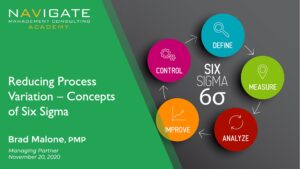While there are many Key Performance Indicators that are useful in managing your systems integration business, Navigate finds three that are critical and not valued highly enough.
These three critical Key Performance Indicators help us predict future results:
- Monthly P&L, specifically recognized revenue for the period
- Monthly new orders (customer commitments for future business)
- Beginning and ending monthly backlog
These KPIs are intertwined. New orders for the month add to the beginning month backlog balance and recognized revenue subtracts from the beginning month backlog. Together they provide the ending month backlog.
Since there are always change orders, customer cancellations and revisions to the contract amount, I find that it is best to calculate net new orders, rather than simply log all the sales wins as new orders. Otherwise, you do not have a balanced equation.
New Orders = Ending Monthly Backlog – Beginning Monthly Backlog + Monthly Recognized Revenue
And yes, new orders can be negative for the month due to prior period corrections, especially if there was a large contract cancellation.
The first critical key performance indicator, recognized revenue, is obviously vital to your business success. What is not obvious is the importance of getting your books closed quickly so you have this information to use in forecasting the following months’ revenue.
Too many integrators close their books 20 to 60 days after the period closes so that they can be accurate. This lag is oftentimes due to lack of process control over time reporting, expenses, bank reconciliation, purchase orders, and subcontractor invoicing among other factors.
If you cannot close your books with accuracy within three business days of the end of the period, even with the use of estimates, then you will be limited in your ability to forecast the following month’s results and unable to take decisive action to manage to that month’s business level.
By not understanding the predictive value of backlog on the next month’s results or the new order trends on next month’s sales levels, owners let their accounting and finance teams drag out closing the books, preferring precision over strategic business intelligence for the future. Joel Harris
By now, a thoughtful integrator would say these are LAG indicators, not leading indicators, so what do they have to do with predicting future business results? Who cares if it takes 30 or even 60 days to close out my books? That is an exercise in looking in the rearview mirror, and I cannot control the past.
While this is true, it is also true that the timely review of your monthly business results will allow you to make timely changes for the following month. Further, it is also true that when you learn how your new order trends affect next month’s sales levels, and when you learn how your backlog affects next month’s business results, you should be highly motivated to make this activity a priority for your accounting and finance teams.
Now that you understand the three critical KPIs that help predict future results, stay tuned for Part 2 of this disucssion, How to Generate a Monthly Revenue Forecast from Your Backlog.
Joel Harris concurrently serves as a Strategy and Business Consultant with Navigate Management Consulting, and the COO for HB Communications.
 Do you want to learn more?
Do you want to learn more?
Join Navigate Academy!
Don’t miss our next live webinar
Friday, Nov 20 @ 11 am CDT
Title: Reducing Process Variation – Concepts of Six Sigma
Keep Reading:
So, All I Have to Do to Be Profitable is Hire Subcontractors?






